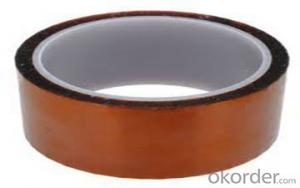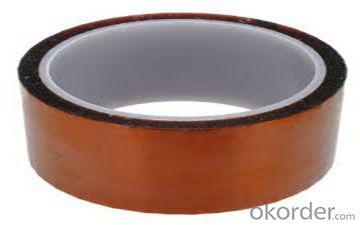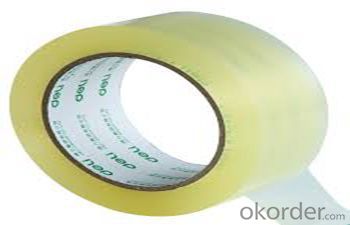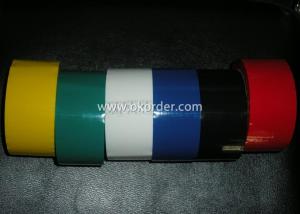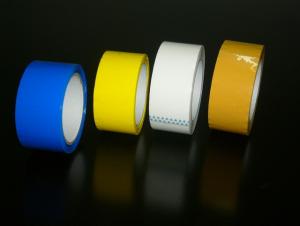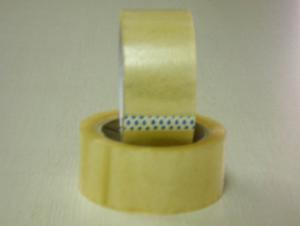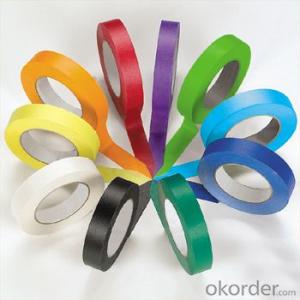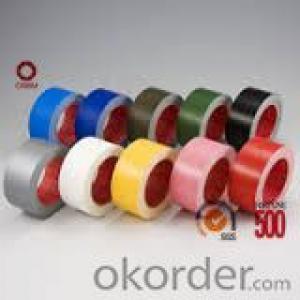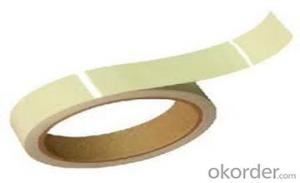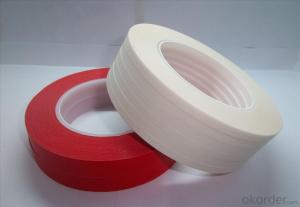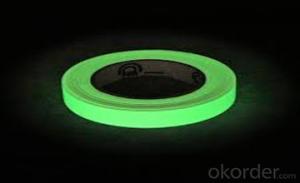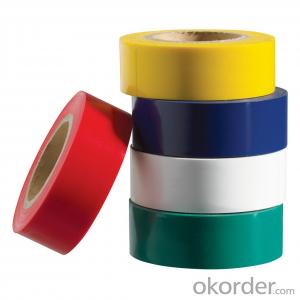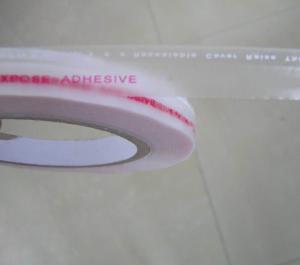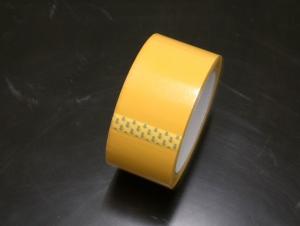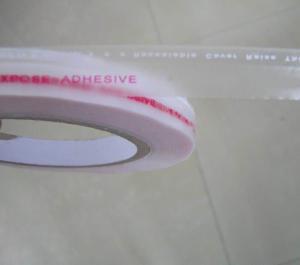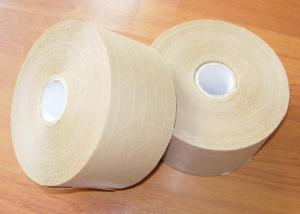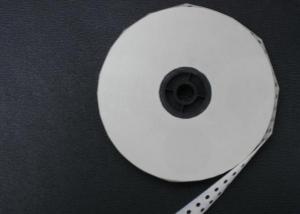Glow Adhesive Tape Rubber Antistatic Pressure Sensitive - Parts of Packaging Tape
- Loading Port:
- Tianjin
- Payment Terms:
- TT OR LC
- Min Order Qty:
- 100 roll
- Supply Capability:
- 500000 roll/month
OKorder Service Pledge
OKorder Financial Service
You Might Also Like
1.Product details
| Adhesive : | acrylic or hot melt | |||||
| hot melt | acrylic | |||||
| Total Thickness | 90mic±10mic | 100mic±10mic | ||||
| Paper Thickness | 70mic | 70mic | ||||
| 180 Peel Adhesion (stainless stell) | ≥8N/25mm | ≥3N/25mm | ||||
| Holding Power | ≥4 hours | ≥3 hours | ||||
| Tensile Strength | 50N/25cm | 50N/25cm | ||||
| Elongation | <10%< span=""> | <10%< span=""> | ||||
| Temperature resistance | 100℃/1 hour | 110℃/1 hour | ||||
| Total Thickness Allowance : +/-1 microns. | ||||||
| *Data represents the minimum value from the results of a series of tests. | ||||||
| Storage Conditions: | Store in a clean dry place. Temperature of 25℃ +/-2℃ and 55% +/-5% relative humidity is recommended. | |||||
2.Packaging & Delivery
Packaging Details:
1 or 5 or 6 rolls/shrink,
36 or 50 or 72 rolls/carton(or as customer's requirement)
1 rolls shrink or 6 rolls stand shrink or 6 rolls flat shrink
for glow masking washi paper tape
3.Features
1. Different styles, varied designs, varity of colors.
2.Acid-free, lignin-free, waterproof.
3.Repositionable, writeable, tearable.
4.Safety hand tear, easy to remove, no residue.
5. Soft and thin paper.
4.Company information
China National Building Material Group Corporation(CNBM), estiblished in 1984, as the largest group corporation of building materials in China. It ranked the 267th among the global FORTUNE 500 CORPORATIONS. And it's a China state-owned enterprise, ranked the 143 large-scale groups under the administration of the state-owned Assets supervision and administration commission of the state council.
With thelargest geosynthetics base about 667000m2 in China and have about 120production lines for all geo materials. For geotextile, our production capacity each day can be 300,000m2. We warmly welcome your order and visit. CNBM guarantee good quality and serivce with comptetitive prices.
5.product show

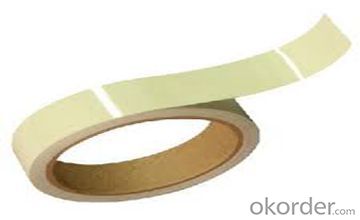
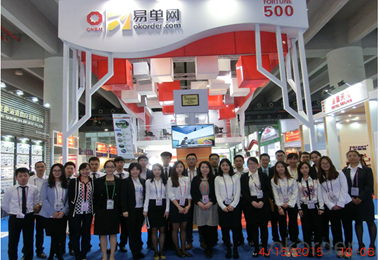

6.Our service
(1)24 hours prompt reply by email or telephone or messenger.
(2)Standard size have stock, immediately delivery once your purchase
(3)10 days delivery containers for out of stock
(4)Can combine containers with multiple insulation products for your different demand
(5)No quantity limit, from 1 rolls to full container, at your choose and demand!
- Q: Can packaging tape be used for other purposes?
- Yes, packaging tape can certainly be used for other purposes beyond its primary use of sealing packages. Due to its strong adhesive properties and durability, it can be used for various other applications. One common alternative use of packaging tape is for organizing and bundling items together. Whether it's sorting cables and cords, securing loose items, or grouping similar items, packaging tape can effectively keep things neatly organized. It can also be used to secure items to walls or surfaces temporarily, such as posters or decorations, without causing any damage. Additionally, packaging tape can be utilized for crafting and DIY projects. Its adhesive nature makes it a great material for creating temporary or permanent bonds between different materials. It can be used to repair torn papers, create labels or tabs, or even make custom stickers. Its versatility and availability in different widths and lengths make it a handy tool for various creative endeavors. Moreover, packaging tape can be utilized for household fixes and repairs. From mending broken items to reinforcing weak joints, the strong adhesive properties of packaging tape can provide a quick and temporary solution. It can also be used to seal minor leaks or cracks temporarily until a proper repair can be made. In conclusion, while packaging tape is primarily designed for sealing packages, its strong adhesive properties and versatility make it suitable for various other purposes. Whether it's organizing, crafting, or quick fixes, packaging tape can be a useful tool to have on hand.
- Q: Can packaging tape be used for sealing arts and crafts materials?
- Packaging tape is indeed suitable for sealing arts and crafts materials. Its versatility as an adhesive enables it to effortlessly attach and secure a wide range of materials such as paper, cardboard, fabric, and more. Whether you need to seal envelopes, wrap gifts, or engage in art projects, packaging tape guarantees a sturdy and durable bond, ensuring the secure sealing of your arts and crafts materials. Moreover, its transparent nature allows it to seamlessly blend with your project, making it an exceptional option for sealing arts and crafts materials.
- Q: Does packaging tape come in different materials for specific applications?
- Different materials are used for specific applications when it comes to packaging tape. One type that is commonly used is polypropylene, which is a versatile material suitable for general-purpose packaging. It is strong, durable, and resistant to moisture and temperature changes, making it suitable for a wide range of uses. However, for more specialized purposes, different materials may be necessary. For example, if you need extra security or tamper-evident features, you might consider using security tape. This type of tape is often made of thicker and stronger materials like polyester or reinforced paper. It is designed to leave a visible mark or message when tampered with. In certain situations, packaging tape specifically designed for extreme temperature conditions may be required. For instance, if you are shipping goods that will be exposed to freezing temperatures, you will need to use freezer-grade packaging tape that remains adhesive and effective in low temperatures. Similarly, some applications may call for tape that can adhere to challenging surfaces like corrugated cardboard or recycled materials. In such cases, you can choose packaging tape with aggressive adhesive properties or one that is specifically formulated for adhesion on difficult surfaces. Moreover, there are eco-friendly options available for those who prioritize sustainability. Environmentally friendly packaging tapes are often made from renewable or recycled materials and use non-toxic adhesives. In conclusion, the choice of packaging tape material depends on the specific requirements of the application, such as security, temperature resistance, surface compatibility, or environmental concerns. It is essential to select the appropriate tape to ensure the safe and secure packaging of your items.
- Q: What are the different types of packaging tape?
- There are several different types of packaging tape available for various packaging needs. 1. Clear Packaging Tape: This is the most common type of packaging tape, typically made from polypropylene or acrylic materials. It is transparent, allowing for easy visibility of labels or printed information on the package. Clear packaging tape is versatile and suitable for most general packaging applications. 2. Brown Packaging Tape: Also known as brown packing tape or brown carton sealing tape, this type of tape is made from strong, durable materials such as polypropylene or paper. It is commonly used for sealing cardboard boxes or packages, providing a secure and tamper-evident seal. Brown packaging tape is ideal for shipping and general packaging purposes. 3. Masking Tape: While not specifically designed for packaging, masking tape can be used for light-duty packaging tasks. It is made from a thin and easily tearable paper and is commonly used for holding, bundling, or labeling packages. However, masking tape may not provide the same level of strength and security as dedicated packaging tapes. 4. Duct Tape: Similar to masking tape, duct tape is not primarily designed for packaging purposes but can be used in certain situations. It is a strong and durable tape, typically made from cloth or reinforced with fibers, and is known for its adhesive strength and versatility. Duct tape can be used for heavy-duty packaging tasks or for securing packages in challenging environments. 5. Specialty Packaging Tapes: There are various specialty packaging tapes available to cater to specific needs. Some examples include fragile tape, which has a warning message to indicate delicate items inside the package, or double-sided tape, which allows for secure attachment of items or joining of materials. Additionally, there are tapes designed for specific industries, such as freezer tape for sealing packages in cold storage or electrical tape for insulating electrical wires during packaging. Overall, the choice of packaging tape depends on the specific requirements of the packaging task, including the type of materials being sealed, the desired level of security, and any specific conditions or considerations.
- Q: Can packaging tape be used for sealing foam or bubble wrap?
- Certainly! Sealing foam or bubble wrap is indeed possible with packaging tape. This type of tape is specifically engineered with a potent adhesive that effectively sticks to different surfaces, such as foam and bubble wrap. To securely seal and safeguard your belongings during transportation or storage, simply affix the packaging tape onto the edges or seams of the foam or bubble wrap. It is crucial to ensure that the tape is correctly and firmly applied to achieve a snug seal, preventing any possibility of the foam or bubble wrap coming undone.
- Q: What are the benefits of using silent packaging tape?
- There are several benefits of using silent packaging tape. Firstly, silent packaging tape provides a noise-free packaging experience. This is particularly beneficial in environments where silence is necessary, such as in offices, libraries, or other quiet spaces. By eliminating the loud noise typically associated with traditional packaging tape, silent tape helps maintain a peaceful and calm atmosphere. Secondly, silent packaging tape is preferred by employees who handle packaging tasks on a regular basis. The absence of noise during the taping process reduces the risk of noise-induced stress or fatigue, contributing to a more comfortable working environment. This can lead to increased productivity and employee satisfaction. Moreover, silent tape is a great option for businesses that prioritize customer satisfaction. When packaging items for shipment, especially fragile or delicate items, using silent tape ensures a professional and polished appearance. The absence of loud noise during the packaging process also avoids potential disturbance or annoyance to customers, both during the packaging phase and when they receive their packages. Additionally, silent packaging tape is often designed with high-quality adhesive properties. This means that it provides a secure and durable seal, keeping packages intact during transit. This reduces the likelihood of damaged goods and the associated costs of re-shipping or replacing items. Lastly, silent tape is often made from eco-friendly materials. This is advantageous for businesses aiming to reduce their environmental impact. By choosing silent packaging tape made from recyclable or biodegradable materials, companies can align their packaging practices with their sustainability goals. In conclusion, the benefits of using silent packaging tape include noise reduction, improved employee satisfaction and productivity, enhanced customer experience, secure sealing, and eco-friendliness. By opting for silent tape, businesses can create a more efficient, pleasant, and environmentally conscious packaging process.
- Q: Can packaging tape be used for sealing pet food or treats?
- Indeed, pet food or treats can be effectively sealed using packaging tape. This tape guarantees a sturdy and reliable seal, ensuring the preservation and protection of the contents. However, it is crucial to verify the safety of the tape employed, ensuring its non-toxicity and absence of any harmful substances that could potentially be consumed by the animals. It is highly recommended to opt for pet-safe packaging tape specifically crafted for the purpose of sealing pet food or treats, as it adheres to all necessary safety standards and regulations.
- Q: How does packaging tape perform when exposed to chemicals or solvents?
- Packaging tape typically performs well when exposed to chemicals or solvents. It is designed to be resistant to many common chemicals and solvents, ensuring that it maintains its adhesive properties and stays securely attached to the package. However, the specific performance may vary depending on the type of tape and the specific chemical or solvent involved.
- Q: Can packaging tape be used for sealing packages with perishable items?
- No, packaging tape is not suitable for sealing packages with perishable items as it does not provide the necessary insulation or protection needed to maintain the freshness and quality of such items. It is recommended to use specialized packaging materials such as insulated boxes or coolers along with appropriate sealing methods for perishable items.
- Q: Can packaging tape be used for sealing storage containers?
- Yes, packaging tape can be used for sealing storage containers.
Send your message to us
Glow Adhesive Tape Rubber Antistatic Pressure Sensitive - Parts of Packaging Tape
- Loading Port:
- Tianjin
- Payment Terms:
- TT OR LC
- Min Order Qty:
- 100 roll
- Supply Capability:
- 500000 roll/month
OKorder Service Pledge
OKorder Financial Service
Similar products
Hot products
Hot Searches
Related keywords
